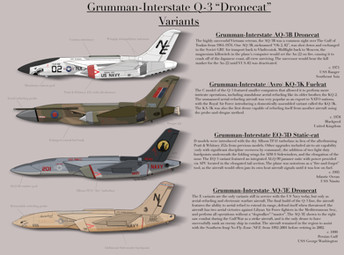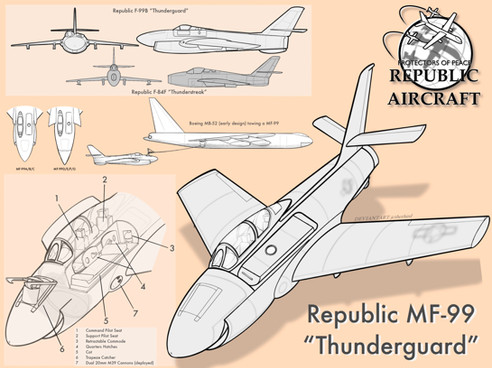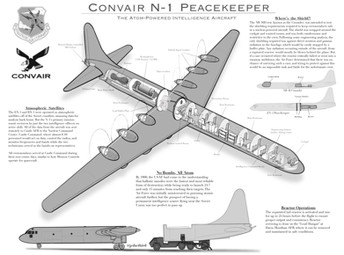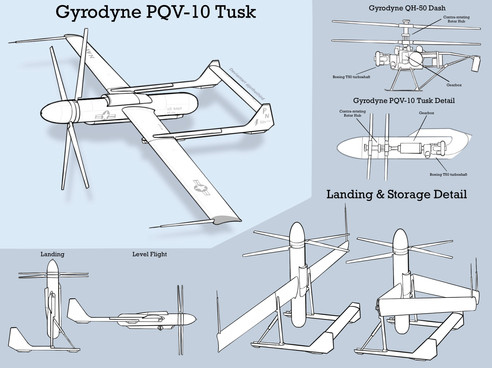HOME | DD
 jcthethird — More C-130 Flying Camp Variants
jcthethird — More C-130 Flying Camp Variants

#aircraft #airforce #airplane #artillery #c130 #coldwar #defense #flying #lockheed #missile #missilelauncher #missiles #patriot #plane #usaf #missilepod #air_force #cold_war #aircraftairplane #missile_launcher #general_dynamics #aircraftconcept #earlywarning #anti_aircraft #aircraftdesign #us_air_force #surface_to_air_missile #sam_site #missile_defense #early_warning
Published: 2022-09-09 04:52:34 +0000 UTC; Views: 6563; Favourites: 86; Downloads: 40
Redirect to original
Description
Flying Barracks (GC-130)Lockheed designed the first flying camp C-130s to swap out the existing APU for a full-sized generator that could operate for extended periods at ground level, followed by Stole Tents to hang from under the wings and tail section. The GC-130D flying barracks could also act as a deployable command center, which was introduced in 1969 and served the US Air Force and Army in Vietnam. While the initial variants were unarmed, later versions introduced the "pop-up" machine-gun nests and watch towers that helped give the aircraft a defensive capability.
Flying Control Tower (GEC-130D Looking Glass)The first design to really make use of its tail section as an additional component was the GEC-130 Looking Glass, which added a small, 2 inch thick baseboard on top of the tail along with installable ladder rungs leading up to it that allowed for crew to reach it. On the sides of the tail were two heavy "hitch" arms, which were kept folded in flight and when not in use. In the center of the baseboards was a series of little compartments and hatches, inside of which was a pair of winches/hoists, a pair of threaded jacks, and retracted antenna cables.
Installation of the Control TowerOnce the aircraft had landed and was in position, crew would begin installing the ladder rungs (and the hoop fall-guards on later builds) while another group rolled out what looked like a stack of metal boards. When the last rung was in and the tail team could climb onto the top section, they would open the outer two hatches, run out a series of guide wires down to the ground to protect the tail and the horizontal stabilizer, and let down the two winch cables to drag the equipment. On the ground, the ground team would hook the boards at which point they were dragged along the guide wires up to the tail top. Once at the top, the first hitch arm was installed before the second to prevent falling. Once the restraints and straps were removed the threaded jacks, driven by a motor at the base of the tail, would rise, pushing top panel upwards to unfold the control tower structure. Once at its peak, the crew would board through a small hatch at the front and pushout the glass panels to their intended positions and latch them together. Next, the antenna housings were raised to improve the radio range of the aircraft. While this happened, crew would pull up the required operations equipment via a pulley that ran a board up and down the guide wires, then install it in the required positions at the top.
Inside of the plane was where the majority of the work was transpiring, as crews worked diligently to create a basic ATC operation. While the traffic pattern and any visible work was to be run from the top of the tail section, all planning, coordinating, and "blind work" was being done internally.
DeploymentThe first GEC-130 Looking Glass was deployed in 1970 to Berlevåg Airport near the farthest Northern reaches of Norway, where the aircraft was used to facilitate impromptu NATO operations where P-3 Orions, U-2 spyplanes, and their support C-130s would takeoff from before they went on patrol near the Soviet border and return to when complete.
Ground-based Defense (GMC-130 Sentry Close/Sentry Mid/Sentry Far)Ground-based aircraft defense was a new idea that had been started while the Air Force was focused on operations in the Middle East and Africa. To counter the possibility of warlords or small arms combatants from a similar tactic as the Tet Offensive, Lockheed and Rockwell Collins developed a retractable machine-gun nest for the C-130 that would provide 50 caliber fire support, which was enough to stop all incoming threats smaller than an armored vehicle. A platform similar to that used on the GEC-130 Looking Glass was installed for lookouts and later for rangefinding. The first tests were conducted in 1972, with the Air Force labeling it as Sentry followed by Sentry Close when the plans for intermediate and long-ranged fire support were developed.
Sentry Mid was fitted with long-tube mortar launchers on the fronts and backs of the wing as well as a curved rail on the wingtips which gave the mortar teams 360 degrees of fire support capability and 5km of range. Sentry Far, introduced in 1976, was outfitted with 4x MGM-52 Lances, which were often fitted with W70 atomic warheads for dealing with anti-armor operations. Later versions of all Sentry models introduced MIM-9 and MIM-115 missiles for air defense while Sentry Mids were fitted with MGM-71 TOW or MGM-157 missile launchers in the wing root and guidance system on-top of the tail, while Sentry Far introduced the MGM-168 (M57) ATACMS to replace the Lances when they were done.
British Ground-based Defense (C-130 GDC)Beginning in the late 1970s, the Royal Air Force began toying with their own take on the Sentry Mid platform, replacing the MGM-71 TOW missiles with the Swingfire anti-tank missile and changing the position of the launcher from the rear to the front of the aircraft. At the same time, the RAF would test the idea of carrying artillery as well, but would come up with an impressive way of doing it. Rather than carry the gun internally and limiting themselves to a single L118 or comparable gun, the underwing pylons were modified to carry them externally with no fairing, allowing for the RAF to carry two into a combat zone while freeing up more space inside of the fuselage for supplies and cargo. Following the successful use of the aircraft from Mt. Pleasant Airfield in the Falklands, the aircraft was updated with TOW missile tubes at the rear, later replaced by larger NLAW or Starseeker missile tubes. The artillery pieces were kept as L118/L119s, but additional variants included TOW and A-A missile units as well, all of which could be deployed at a moments notice upon landing.
Communications and Command Base (GEC-130 Relay Max)
The next phase of the C-130 command base was as a dedicated command and communications station, which took the barracks variant and installed a series of broadcast and receiver relays that were capable of operating in the air, but were mainly designed for deployment when on the ground, allowing for long-term radio communication deployments. The tail platform that was used and developed for the Looking Glass platform was removed to allow for the low-frequency radio towers to deploy.
Later variants were equipped with short-range surface-to-air missile defenses (MIM-9/MIM-115) which were implemented for frontline defense. The aircraft was often deployed alongside Looking Glass and Sentry Far units as communications boosters.
Artic SAM Site (GLMC-130 Arctic Sentry I & II)Following the plan to retire the Douglas GLMC-133 Arcticmaster , the US Air Force needed a replacement that could support their lucrative Arctic picketline. Plans were looked at to use the McDonnell Douglas C-133 Super Cargomaster as the base design, but they thought that it might be too large for what they were trying to do. In the early 1980s the US Air Force decided to opt for the GMC-130 Sentry Far as a base, as they looked to it for non-Arctic operations in Europe and other possible installations around the world once the anti-aircraft variant proved itself.
The design used similar approaches to operating like the Arcticmaster had, with the added benefit of a CIWS installment for anti-munitions and close-in anti-air. For cold operations, the aircraft was fitted with similar inflatable buffers like the GLMC-133, but it also employed an extra thick insulation layer that had not been used on the previous aircraft, which reduced the heat loss the aircraft had to reclaim with heaters and exhaust siphoning.
GLMC-130F Arctic Sentry I was first flown in 1982, and would help phase out the GLMC-133 by 1984. In 1999, Arctic Sentry II was introduced, which was the first of the flying camp types to implement a nuclear reactor, albeit small, to help with both powering the aircraft and heating the cabin.
SAM Site (GMC-130 Sky Sentry)The GMC-130 Sky Sentry was essentially the same aircraft as the GLMC-130 minus the cold-operation modifications. To improve the role, for dealing with smaller and faster threats, the aircraft would carry MIM-9s or MIM-115s. The Phalanx CIWS was given a larger magazine and additional incoming threat detectors to mark targets for the gun to quickly snap to after dispensing a burst at one incoming threat. The first units appeared in 1983 and saw routine deployment across Europe, the Middle East, and in Africa.
Sky Sentry variants followed in the footsteps of Arctic Sentry II with the atomic reactor, as it added a radiation factor that the Soviet Union was hesitant to target for fear of spreading radiation prior to an invading forces' arrival. Only a handful of aircraft saw this conversion and very few would ultimately see deployment due to concerns with Soviet first strikes, but it forced the Soviets to reconsider attacking the Sentry aircraft.
Iranian Defense Type (GMC-130 Zafar)The Iranians had begun operating Sentry Close units in 1976 for defense of their airbases in Western Iran, but had their orders for Sentry Far type aircraft cancelled as the Revolution became a concern. Despite their cancellation, the newly formed Islamic Republic of Iran willingly assembled a number of the aircraft with the intent to use their leftover missiles. The aircraft was developed similarly to the GMC-130 Sentry Far, copying a number of the simple configurations that could be gleaned from the few cursory images that they had. The aircraft was fitted to carry the Chinese-modified variant of the S-75 Dvina (SA-2) that was converted into a surface-to-surface ballistic weapon, known as the CSS-8. These weapons, which had displeased the Iranian Missile Forces due to their poor range, were put to better use with the Zafar (Farsi for "Victory"), starting in 1993. In 2005, the Fateh-110 replaced the CSS-8 as the primary weapon, fitted for chemical and biological attacks from Western and Eastern airbases.
Multi-role Defense (GMC-130J Max Sentry)The Max Sentry Program was inaugurated in 2003 as a means of combining the efforts of the Sentry Far/Mid and Sky Sentry variants into a mixed build that was tasked for all available roles for remote firebase deployments. The resulting Max Sentry was basically a Sky Sentry variant, complete with a 20mm Phoenix CIWS , MIM-104 Patriot missile launch pods, and tail mounted radar, with the added benefits of the Sentry Far's MGM-168 (M57) short-range missiles (replaced one MIM-104 launcher on each wing), and the wing-root MGM-71 TOW/MGM-157 launchers for TV-guided support. Because of the combat nature of the aircraft, the plans for a nuclear reactor powerplant were scrapped.
While the initial plan was for the aircraft to be deployed as firebases, concerns were raised in Afghanistan and Iraq following suicide bomb attacks on other US military static defenses that a standalone aircraft such as the Max Sentry was too risky to have operating alone, especially with a fuel storage onboard. The aircraft was often deployed to support airbases, and was routinely used to launch anti-vehicular missiles at threats.
Japan Island Defender Site (GMC-130 Accord)The Japanese Air Self Defense Forces (JASDF) decided to research into their own variant of the Max Sentry, which was led by Subaru (then Fuji Heavy Industries) and with Mitsubishi providing components, programming, and weapons. Unlike the Max Sentry, the Accord design did not include a high-powered Phalanx/Phoenix CIWS, opting instead to put any anti-aircraft systems on the ground if they were needed. The aircraft was designed to carry a single JTPS-P15 radar-armed utility vehicle in the tail, which would deploy for triangulation purposes against ships. For air defense, the aircraft carried four Type 81 (Tan-SAM) units mounted to the wing-tips, and two Type 03 (Chu-SAM) medium range missile pods. For land-defense, the aircraft carried up to four of the Type 12, Type 80, or Type 88 anti-ship cruise missiles as well as a number of close range MGM-71 TOW missiles for landing ship defense. For crew housing, tents were kept at the tail section, but additional crew bunking could be established behind the aircraft for safety.
The main intent of the aircraft was deployment to contested islands in the East China Sea and the Sea of Japan, where the aircraft could instantaneously deploy a full defense regiment if properly supported by JSDF soldiers. The reveal of the aircraft came in 2008, followed almost instantly by the unit's deployment to the Senkaku Islands later that year. An export variant of the aircraft to South Korea was officially designated as the Lockheed Martin/Subaru GMC-130H Accord.
See AlsoRelated content
Comments: 5

👍: 1 ⏩: 1

👍: 0 ⏩: 0

👍: 1 ⏩: 1

👍: 1 ⏩: 1

👍: 0 ⏩: 0

























